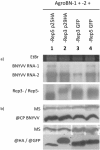Agroinoculation of Beet necrotic yellow vein virus cDNA clones results in plant systemic infection and efficient Polymyxa betae transmission
- PMID: 23384276
- PMCID: PMC6638874
- DOI: 10.1111/mpp.12018
Agroinoculation of Beet necrotic yellow vein virus cDNA clones results in plant systemic infection and efficient Polymyxa betae transmission
Abstract
Agroinoculation is a quick and easy method for the infection of plants with viruses. This method involves the infiltration of tissue with a suspension of Agrobacterium tumefaciens carrying binary plasmids harbouring full-length cDNA copies of viral genome components. When transferred into host cells, transcription of the cDNA produces RNA copies of the viral genome that initiate infection. We produced full-length cDNA corresponding to Beet necrotic yellow vein virus (BNYVV) RNAs and derived replicon vectors expressing viral and fluorescent proteins in pJL89 binary plasmid under the control of the Cauliflower mosaic virus 35S promoter. We infected Nicotiana benthamiana and Beta macrocarpa plants with BNYVV by leaf agroinfiltration of combinations of agrobacteria carrying full-length cDNA clones of BNYVV RNAs. We validated the ability of agroclones to reproduce a complete viral cycle, from replication to cell-to-cell and systemic movement and, finally, plant-to-plant transmission by its plasmodiophorid vector. We also showed successful root agroinfection of B. vulgaris, a new tool for the assay of resistance to rhizomania, the sugar beet disease caused by BNYVV.
© 2013 BSPP AND BLACKWELL PUBLISHING LTD.
Figures



References
-
- Adams, M. (1991) Transmission of plant viruses by fungi. Ann. Appl. Biol. 118, 479–492.
-
- Bleykasten‐Grosshans, C. , Guilley, H. , Bouzoubaa, S. , Richards, K.E. and Jonard, G. (1997) Independent expression of the first two triple gene block proteins of Beet necrotic yellow vein virus complements virus defective in the corresponding gene but expression of the third protein inhibits viral cell‐to‐cell movement. Mol. Plant–Microbe Interact. 10, 240–246.
-
- Bornemann, K. and Varrelmann, M. (2011) Analysis of the resistance‐breaking ability of different Beet necrotic yellow vein virus isolates loaded into a single Polymyxa betae population in soil. Phyopathology, 101, 718–724. - PubMed
-
- Briddon, R.W. , Watts, J. , Markham, P.G. and Stanley, J. (1989) The coat protein of Beet curly top virus is essential for infectivity. Virology, 172, 628–633. - PubMed
-
- Canova, A. (1959) On the pathology of sugarbeet. Inf. Fitopatol. 9, 390–396.
Publication types
MeSH terms
Substances
LinkOut - more resources
Full Text Sources
Other Literature Sources

